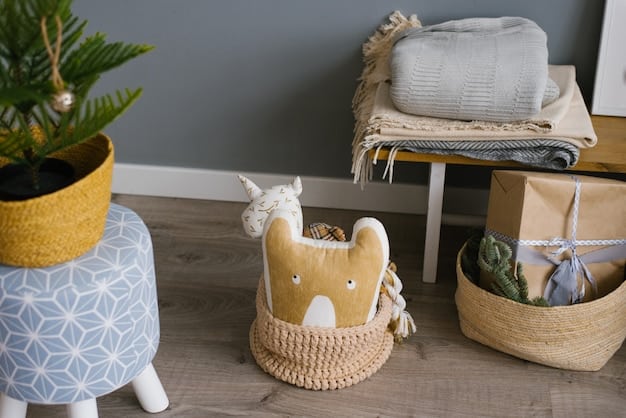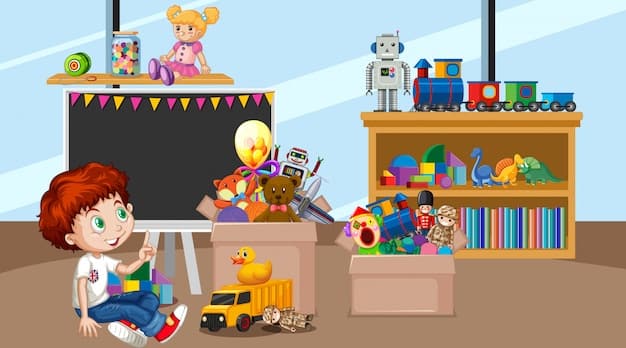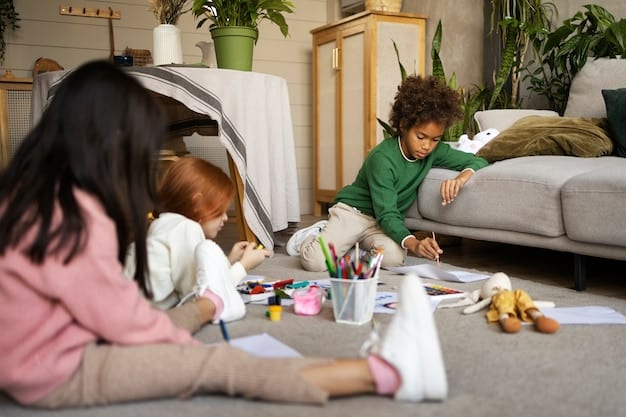Creating a Calm Home: Stress-Reducing Tips for Parents

Creating a calm and organized home involves decluttering, establishing routines, designating specific areas for activities, and involving the whole family to reduce stress and create a more peaceful environment for everyone.
Is your home feeling more like a chaotic jungle than a peaceful sanctuary? Many parents struggle with maintaining a calm and organized home amidst the demands of family life. This article provides practical tips for creating a calm and organized home, reducing stress, and fostering a more harmonious environment for everyone.
Creating Zones for Different Activities
One of the first steps in creating a calm and organized home is to designate specific areas for different activities. This helps to contain the mess and makes it easier to maintain order.
Defining Spaces
Clearly define each space in your home according to its primary function. This could mean setting up a reading nook in a quiet corner or creating a designated play area for children.
Maximizing Space
Utilize vertical space with shelves and storage units to maximize the available area. This is especially useful in smaller homes where space is at a premium.
- Use labeled bins and baskets to store items in an organized manner.
- Hang shelves to store books, toys, and other essentials.
- Implement space-saving furniture like ottomans with storage.
By creating distinct zones for activities, you can minimize clutter and make it easier to keep each area tidy. This contributes to a more organized and peaceful home environment.

Decluttering: The Foundation of a Calm Home
Decluttering is essential for creating a calm home. A cluttered environment can lead to stress and overwhelm. Regularly decluttering helps to free up space and create a more peaceful atmosphere.
Identifying Clutter Hotspots
Start by identifying the areas in your home that tend to accumulate the most clutter. These could be entryways, countertops, or closets.
The Decluttering Process
Go through each item in the hotspot and decide whether to keep, donate, or discard it. Be honest with yourself about what you truly need and use.
- Adopt the one-in, one-out rule: for every new item you bring into your home, get rid of one similar item.
- Set a timer for 15-30 minutes and focus on decluttering one small area at a time.
- Donate or sell items you no longer need to give them a new life.
Regular decluttering prevents clutter from accumulating and helps maintain a more organized and stress-free home. This practice supports a sense of calm and control.
Establishing Daily and Weekly Routines
Creating a calm and organized home also involves establishing consistent daily and weekly routines. Routines provide structure and predictability, which can be especially beneficial for families with children.
Morning and Evening Routines
Develop a set of routines for both morning and evening to help everyone stay on track. This could include tasks like making beds, tidying up, and preparing for the next day.
Weekly Cleaning Schedule
Create a weekly cleaning schedule that breaks down household tasks into smaller, manageable chunks. This prevents you from feeling overwhelmed by a huge cleaning project.
- Assign specific days for tasks like laundry, vacuuming, and cleaning bathrooms.
- Involve family members in age-appropriate tasks to share the workload.
- Use a checklist or app to track progress and stay organized.
Establishing daily and weekly routines can transform your home into a more predictable and peaceful environment. These routines instill good habits and lighten the mental load.
Involving the Whole Family
Creating and maintaining a calm and organized home shouldn’t fall solely on one person. Involving the whole family in the process fosters teamwork and responsibility.
Age-Appropriate Tasks
Assign age-appropriate tasks to each family member. Even young children can help with simple tasks like putting away toys or setting the table.
Making it Fun
Turn chores into fun activities by playing music, creating challenges, or offering rewards for completing tasks.

- Create a chore chart that outlines each person’s responsibilities.
- Make cleaning and organizing a family activity by designating a specific time each week.
- Offer positive reinforcement and praise for contributions.
Involving the whole family not only lightens the load but also teaches valuable life skills. Collaborative efforts contribute to a sense of shared responsibility and a more harmonious home.
Prioritizing Storage Solutions
Effective storage solutions are crucial for keeping your home organized. Investing in the right storage options can make a significant difference in maintaining a calm and clutter-free environment.
Clever Storage Ideas
Explore storage ideas like using under-bed storage containers, installing floating shelves, or utilizing multi-functional furniture with built-in storage.
Organizing Closets
Organize closets by category, such as clothing, linens, or accessories. Use matching hangers, shelf dividers, and storage bins to maximize space and keep items tidy.
- Invest in stackable storage containers to store seasonal items or items you don’t use frequently.
- Utilize wall-mounted organizers to store tools, craft supplies, or office essentials.
- Use drawer dividers to separate and organize clothing items like socks and underwear.
Prioritizing effective storage solutions helps to keep items organized, easily accessible, and out of sight. Maximizing storage contributes to a cleaner, calmer, and more functional home.
Creating a Relaxing Atmosphere
Beyond organization, creating a relaxing atmosphere can significantly contribute to a calmer home. Incorporating elements that promote relaxation and well-being can transform your living space into a tranquil haven.
Incorporating Calming Elements
Add elements such as soft lighting, soothing colors, comfortable seating, and natural elements like plants to your decor. These additions can create a more inviting and peaceful ambiance.
Minimizing Noise
Reduce noise levels by using sound-absorbing materials like rugs, curtains, and upholstered furniture. Create quiet zones where family members can retreat for relaxation or focused activities.
- Use essential oil diffusers or candles with relaxing scents like lavender or chamomile.
- Play calming music or nature sounds to create a peaceful background ambiance.
- Establish quiet times or no-screen zones to promote relaxation and mindfulness.
Creating a relaxing atmosphere involves attending to sensory details and prioritizing comfort and tranquility. A calming ambiance transforms your home into a sanctuary where you can de-stress and rejuvenate.
| Key Point | Brief Description |
|---|---|
| 🏠 Designated Zones | Create specific areas for activities to minimize clutter. |
| 🗑️ Regular Decluttering | Identify clutter hotspots and declutter frequently to reduce stress. |
| ⏰ Daily Routines | Establish morning and evening routines for predictability. |
| 👨👩👧👦 Family Involvement | Assign age-appropriate tasks to involve the whole family. |
Frequently Asked Questions
▼
Decluttering should be a regular activity, ideally weekly or monthly, to prevent clutter from accumulating. A quick 15-minute session can make a big difference.
▼
Utilize vertical storage solutions, multi-functional furniture, and clear storage containers to maximize space and keep items organized. A minimalist approach helps too!
▼
Assign age-appropriate tasks, make it fun with games or music, and offer praise for their contributions to foster a sense of responsibility towards cleanliness.
▼
Use drawer organizers, shelf dividers, and clear containers to store kitchen items. Maximize cabinet space and keep countertops clear to maintain order.
▼
Incorporate soft lighting, soothing colors, comfortable seating, and natural elements like plants. Minimize noise and add relaxing scents to create a peaceful environment.
Conclusion
Creating a calm and organized home is an ongoing process that requires commitment, consistency, and collaboration. By implementing the tips outlined in this guide, you can reduce stress, enhance productivity, and foster a more harmonious and enjoyable living environment for yourself and your family.





